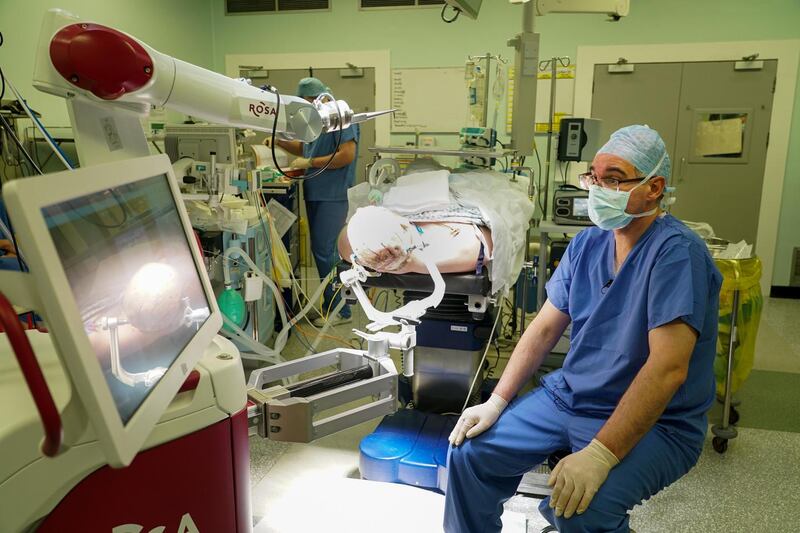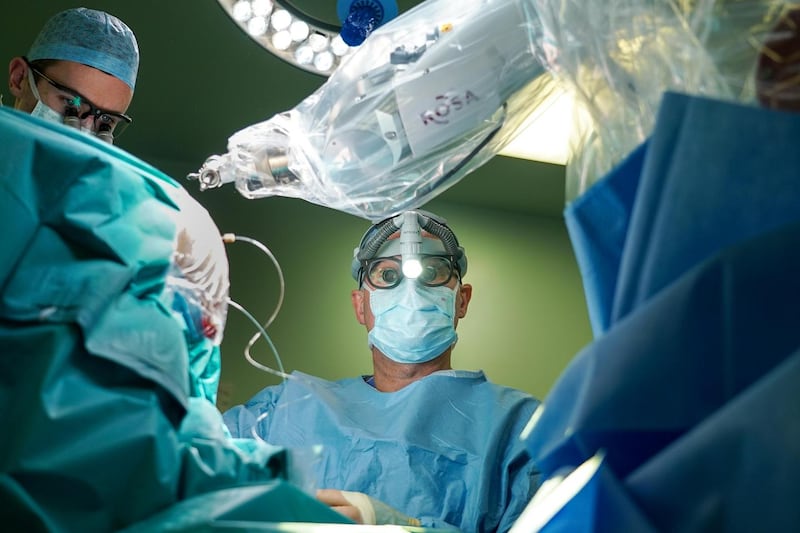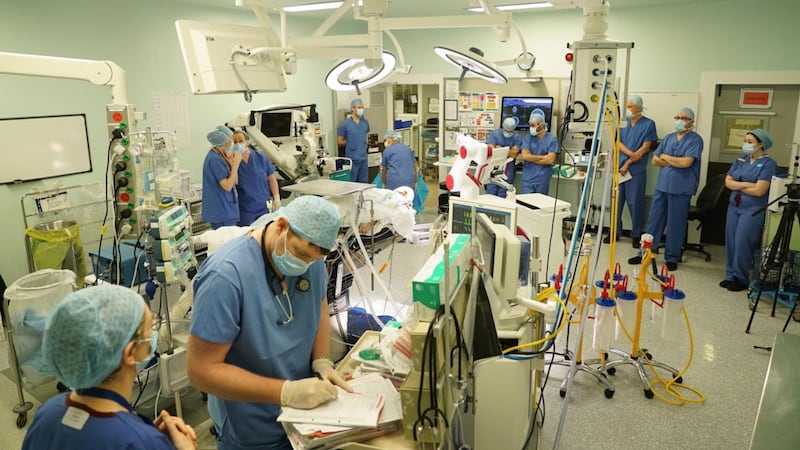For someone who is about to have a series of holes drilled in his skull, Ray seems remarkably calm in his bed in Dublin's Beaumont Hospital.
The 27-year-old from Meath is one of the first patients in Ireland to undergo brain surgery using a new robot that helps specialists at the national neurosurgical centre in the hospital plan complex procedures through small drill holes in the head.
Known as Rosa, the robot acts as a kind of GPS for the skull, guiding surgeons to targets deep inside the brain, while avoiding damage to vital cells. It’s a big change from the traditional approach of surgically removing a flap of bone to access the brain, known as craniotomy, which can be complex, dangerous and painful for the patient.

Ray has severe epilepsy, and his doctors are trying to identify the source, deep within his brain, of his seizures. By removing this tissue they hope to eliminate or at least minimise them. Videographer Enda O’Dowd and I have been invited in to witness the precision placement of electrodes in his brain, using the robot.
Ray says his seizures started 10 years ago and have been getting worse since. “I might get three or four big seizures a week, go a few weeks with nothing, and then they come back.”
“The big ones last a few minutes. You’re very confused afterwards, you wouldn’t know what day it was or where you were.
“It’s hard, you know. You’re completely disabled for minutes. You need someone around you who knows what to do, to move everything away so you don’t hurt yourself. But there isn’t always someone to help; you might be walking down the stairs or at the table and you can do a lot of harm to yourself.”
These worsening medical challenges have forced him to stop working. Driving is also out of the question.
Ray admits to having mixed emotions about undergoing the surgery, but after years of unsuccessful drug treatment and inconclusive scans he doesn’t have much choice.

Typically, a patient suffering seizures will be prescribed a medication regime to control them. They might spend several years trying one drug after another, until one works with, hopefully, few side-effects. If no solution is found, they are declared drug-resistant and other options have to be sought.
Some patients might have lesions that show up clearly on scans and can be removed through uncomplicated surgery.
The removal of parts of the brain is not something that doctors undertake lightly. “What are we supposed to do,” asks Donncha O’Brien, the neurosurgeon carrying out the procedure. “Are we to leave tissue which has no neurological function, which is causing epilepsy and destroying a patient’s life, or are we to remove tissue confident in the knowledge we’ll improve the patient?
“Leaving the tissue just because you don’t want to take out part of the brain, that doesn’t add up, it doesn’t make sense at all.”
Ray’s cognitive function is deteriorating as a result of the seizures, he points out. In O’Brien’s technical lexicon, he is becoming “demented”.
Race against time
Between 0.5 and 1 per cent of the population has epilepsy, though the severity of the condition varies greatly from patient to patient.
Epilepsy is much misunderstood, according to Ronan Kilbride, clinical lead of the national epilepsy programme. "It refers to someone with an enduring risk of seizures, but these can occur for all sort of reasons, some of them childhood-related, or to do with acquired illness or injuries to the brain. So it's a catch-all term for wide variety of clinical scenarios."
The vast majority of cases can be controlled with medication, but 20 per cent of patients – including Ray – have a drug-resistant form of the condition. For many of these, surgery offers the best hope of a seizure-free existence.
It can be a race against time. Uncontrolled seizures can be dangerous, even lethal. Like many with the condition, Ray has a facial scar, the result of a damaging fall during a seizure.
The risk of harm increases 10 per cent per decade among those with drug-resistant epilepsy.
The outcomes from surgery are good, according to Dr Kilbride. “We do 85 respective epilepsy surgeries each year and outcomes match international standards if we can identify the target area successfully, either by scans or surface recordings. In up to 80 per cent of cases, the epilepsy will have been controlled after surgery.”

Complication
In Ray’s case, the scans are clear, so doctors can’t tell where in the brain the seizures are originating. He has been through the hospital’s monitoring unit, where medical staff gather information about the origins of the seizures.
In the unit, high-definition cameras mounted above the patient’s bed are used to work out the nature of the seizures occurring. This information is then correlated with electroencephalograms (EEGs) that record activity deep in the brain.
Doctors observe the patient’s movements during seizures; which arm moves first, for example.
“The rationale is to try to figure out where the seizures are coming from. We think already that they’re coming from the right side of the brain but we have to find out where,” O’Brien explains.
The robot is being used to build on this picture by facilitating the insertion of electrodes into the brain as a way of identifying the exact location of Ray’s seizures.
“A complicating factor is that they appear to be coming from an area known as the insula, an intricate area near the blood vessel and the brain’s main artery,” O’Brien says. “It’s a very delicate area, so the electrodes will have to be placed very accurately, using the robot.”
Ray’s head is shaved before he is transported to the operating theatre, where a large team of medics awaits him. The sites on his skull where electrodes will be drilled are marked with a pen and Rosa, pre-loaded with the information from his scans, is moved into place.
Modern medicine is very much a team effort, aided by cutting-edge technology; aside from O’Brien and his fellow surgeons, the medical team today includes neurologists, anaesthetists and special nurses.
Each of the electrodes has eight contacts that will relay reading from the surface area to deep inside the brain. While the robot measures out exactly where the placements should occur, down to an accuracy of 0.33mm, the surgeons do the actual drilling. With Ray under full anaesthetic, and his head clamped in a metal brace, the arm of the robot is directed to each entry point by the surgeons.
The computer has already built up a three-dimensional picture of the patient’s brain from his scans; a set of screws inserted in the surface of his skull provides further information to help determine the trajectory of the holes to be drilled for the electrodes with the greatest accuracy.
Placing electrodes in the insula is risky; with every pass of an electrode there’s a 1 per cent risk of a haemorrhage inside the patient’s brain. There’s also the risk of infection, which has been minimised through the use of antibiotics and scalp washes in the preceding days.

Plan of action
One by one, the holes are drilled and the super-thin electrodes safely put in place. Ray is woken up once the anaesthetic has worn off.
He is returned to to the monitoring unit, where over the next two weeks doctors will monitor his seizures. To get things moving, his medication will be reduced and he’ll be deprived of sleep until the seizures start to come.
Once they do, they’ll be picked up by the electronic sensors deep in his skull. The electrode nearest the focus of the seizure will pick up a spike before others do, giving vital clues to the source of his brain disturbances.
Once enough information has been gathered, the medical team meet to decide on a plan of action. A week later, Ray is put on the operating table again, this time to remove the abnormal area of his brain.
O’Brien’s job in such situations is to remove the offending brain tissue, possibly as much as 8cm of the cortex.
There is “no price to be paid” to cutting out this part of the brain, he says: “It’s non-dominant cortex, doing nothing, while causing a terrible problem. It’s more than useless, it has no major neurological function.”
Improvement
The placing of electrodes and subsequent surgery on Ray’s skull took place in November 2020. After recuperating, he was placed under further monitoring to assess the changes in his brain activity. Weeks and months will have to pass before the full nature of his brain activity can be established.
Speaking in July, eight months on, O’Brien says the surgery went “reasonably well”.
“Overall, there has been a big improvement. The removal of brain tissue has had an impact on Ray’s seizures, and he had had no serious convulsions.”
However, he continues to have some seizure activity and may need further surgery.
Ray says he is disappointed with the outcome of the surgery. “The good thing is that I haven’t had any blanket seizures, the ones that completely knocked me out. But I still get partial seizures, almost at the same level as before.”
He worries about memory loss and has decided to push the pause button on further surgery due to fears over how it might impact his brain function.
Rosa has since been used by O’Brien in the treatment in a handful of other serious epilepsy cases, allowing surgeons to tailor their interventions when treating seizures. It is also used in Ireland in other contexts, such as deep brain stimulation for patients with Parkinson’s disease.
O’Brien has a waiting list of 30 people who urgently need the surgery to help alleviate their seizure, and reckons he would do 40 or so cases a year.















